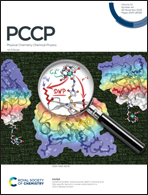A parametric two-mode vibronic model of a dimeric mixed-valence cell for molecular quantum cellular automata and computational ab initio verification
Abstract
In this article we propose a two-mode vibronic model of a molecular cell for quantum cellular automata. The molecular cell is represented by a mixed-valence dimeric cluster in which the mobile electron is coupled to two kinds of molecular vibrations. The first type of vibration is represented by the so-called “breathing” modes localized on the redox sites, which are traditionally considered within the Piepho, Krausz and Schatz vibronic model as a source of the trapping effect. The second type includes the “intercenter” vibration, which changes the distance between the redox centers enhancing thus the degree of delocalization in the bonding orbital of the cell. The cell–cell response function as a key characteristic of the cell is evaluated in the framework of the dynamic (quantum-mechanical) solution of the two-mode vibronic problem. To elucidate the physical sense of precise quantum-mechanical results, a more imaginative semiclassical (adiabatic) picture is used. Competitive effects of the two kinds of active vibrations on the cell–cell response function are analyzed and the conditions are established under which a mixed-valence dimer can work as a functioning molecular cell in a quantum cellular automation device. One of the aims of this article was to combine the parametric approach that gives a very common description (that allows the qualitative comparison of properties in a series of compounds) with the ab initio evaluations providing numerical estimations of the parameters involved in the semiempirical approach for a real molecule. Along with the parametric approach the quantum-chemical modelling is used for investigating the cation-radical of the tetramethyleneethane molecule which was shown to belong to the class of strongly delocalized systems. It was demonstrated that an efficient control over the electronic and vibronic parameters can be achieved through the design of its derivatives through a spacer interposed between the two allyl fragments. The strongly conjugated C![[double bond, length as m-dash]](https://www.rsc.org/images/entities/char_e001.gif) C spacer was shown to partially block the channel mediating electronic communication so that the molecule becomes strongly localized. The interconnection between the parametric and ab initio approaches is established.
C spacer was shown to partially block the channel mediating electronic communication so that the molecule becomes strongly localized. The interconnection between the parametric and ab initio approaches is established.



 Please wait while we load your content...
Please wait while we load your content...